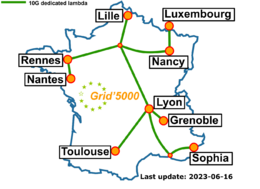Grid5000:Home
|
Grid'5000 is a precursor infrastructure of SLICES-RI, Scientific Large Scale Infrastructure for Computing/Communication Experimental Studies.
|
|
Grid'5000 is a large-scale and flexible testbed for experiment-driven research in all areas of computer science, with a focus on parallel and distributed computing, including Cloud, HPC, Big Data and AI. Key features:
Older documents:
|
Random pick of publications
Five random publications that benefited from Grid'5000 (at least 2924 overall):
- Dorian Goepp, Samuel Brun, Quentin Guilloteau, Olivier Richard. Un prototype de cache de métadonnées pour le passage à l'échelle de NixOS-Compose. COMPAS 2024 - Conférence francophone d'informatique en Parallélisme, Architecture et Système, Jul 2024, Nantes, France. pp.1-8. hal-04632952 view on HAL pdf
- Gautier Evennou, Vivien Chappelier, Ewa Kijak, Teddy Furon. SWIFT: Semantic Watermarking for Image Forgery Thwarting. WIFS 2024 - 16th IEEE International Workshop on Information Forensics and Security, IEEE, Dec 2024, Roma, Italy. pp.1-6. hal-04728070 view on HAL pdf
- Romaric Pegdwende Nikiema, Marcello Traiola, Angeliki Kritikakou. Impact of Compiler Optimizations on the Reliability of a RISC-V-based Core. DFT 2024 - 37th IEEE International Symposium on Defect and Fault Tolerance in VLSI and Nanotechnology Systems, Oct 2024, Oxfordshire, United Kingdom. pp.1-1. hal-04731794 view on HAL pdf
- G. Briffoteaux, N. Melab, Mohand Mezmaz, D. Tuyttens. Investigating surrogate-based hybrid acquisition processes. Application to Covid-19 contact mitigation. Applied Soft Computing, 2024, 151, pp.111134. 10.1016/j.asoc.2023.111134. hal-04383812 view on HAL pdf
- Chih-Kai Huang, Guillaume Pierre. UnBound: Multi-Tenancy Management in Scalable Fog Meta-Federations. UCC 2024 - 17th IEEE/ACM International Conference on Utility and Cloud Computing, Dec 2024, Sharjah, United Arab Emirates. pp.1-11. hal-04760398 view on HAL pdf
Latest news
![]() End of support for centOS7/8 and centOSStream8 environments
End of support for centOS7/8 and centOSStream8 environments
Support for the centOS7/8 and centOSStream8 kadeploy environments is stopped due to the end of upstream support and compatibility issues with recent hardware.
The last version of the centOS7 environments (version 2024071117), centOS8 environments (version 2024071119), centOSStream8 environments (version 2024070316) will remain available on /grid5000. Older versions can still be accessed in the archive directory (see /grid5000/README.unmaintained-envs for more information).
-- Grid'5000 Team 08:44, 4 December 2025 (CEST)
![]() Ecotaxe cluster is now in default queue at Nantes
Ecotaxe cluster is now in default queue at Nantes
We are pleased to announce that the ecotaxe cluster of Nantes is now available in the default queue.
As a reminder, ecotaxe is a cluster composed of 2 HPE ProLiant DL385 Gen10 Plus v2 servers[1].
Each node features:
To submit a job on this cluster, the following command may be used:
oarsub -t exotic -p ecotaxe
This cluster is co-funded by Région Pays de la Loire, FEDER and REACT EU via the CPER SAMURAI [3].
[1] https://www.grid5000.fr/w/Nantes:Hardware#ecotaxe
[2] The observed throughput depends on multiple parameters such as the workload, the number of streams, ... [3] https://www.imt-atlantique.fr/fr/recherche-innovation/collaborer/projet/samurai
-- Grid'5000 Team 14:10, 02 December 2025 (CET)
![]() Some changes on the hardware configuration of Grenoble nodes
Some changes on the hardware configuration of Grenoble nodes
We recently did some hardware changes on clusters yeti, troll and dahu.
The changes are as follows:
- yeti-[1,3]: 1× NVMe
- yeti-[2,4]: 2× NVMe
oarsub request. For example:oarsub -I -p "dahu and opa_count > 0"
-- Grid'5000 Team 14:50, 24 November 2025 (CEST)
![]() Cluster "clervaux" is now in the default queue in Luxembourg
Cluster "clervaux" is now in the default queue in Luxembourg
We are pleased to announce that the clervaux[1] cluster of Luxembourg is now available in the default queue.
Clervaux is a cluster composed of 48 CPU nodes.
Each node features:
This cluster was funded by the University of Luxembourg.
[1] https://www.grid5000.fr/w/Luxembourg:Hardware#clervaux
-- Grid'5000 Team 10:50, 21 October 2025 (CEST)
Grid'5000 sites
Current funding
INRIA |
CNRS |
UniversitiesIMT Atlantique |
Regional councilsAquitaine |



